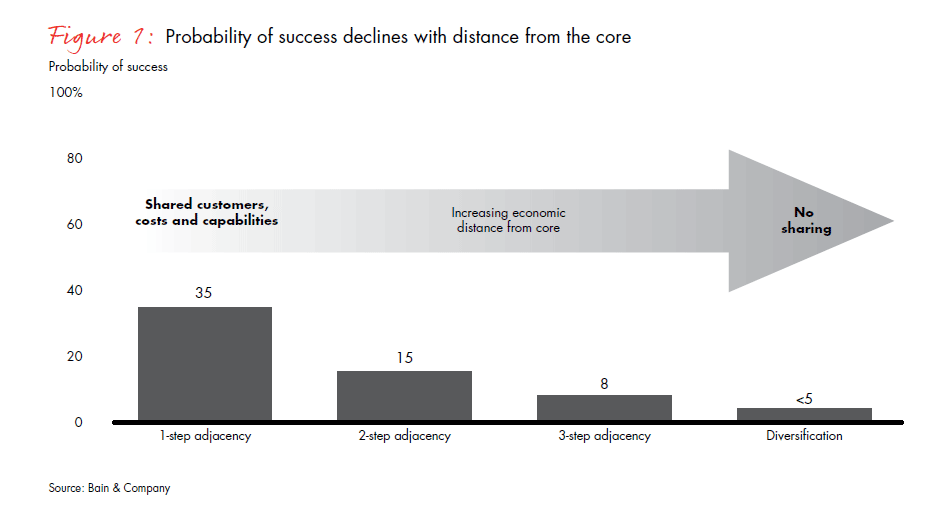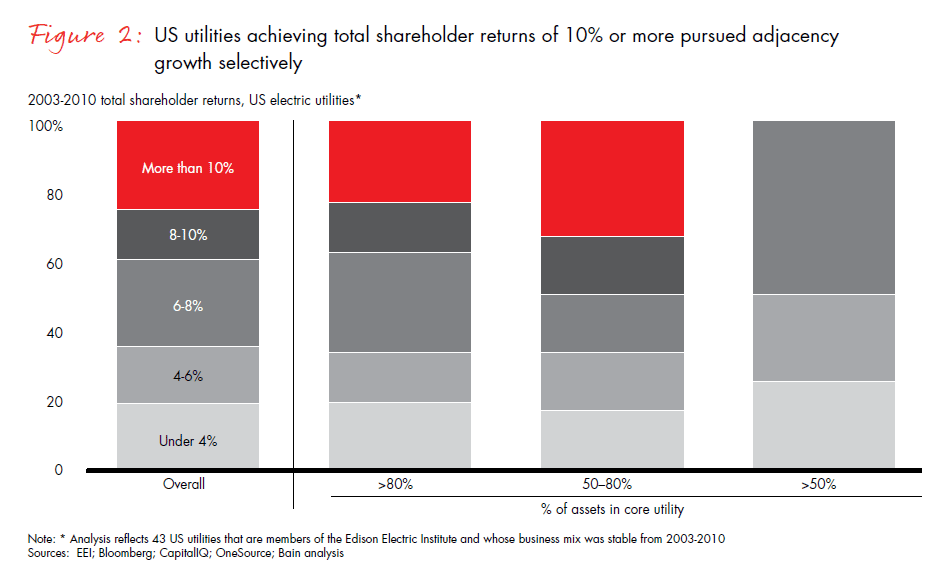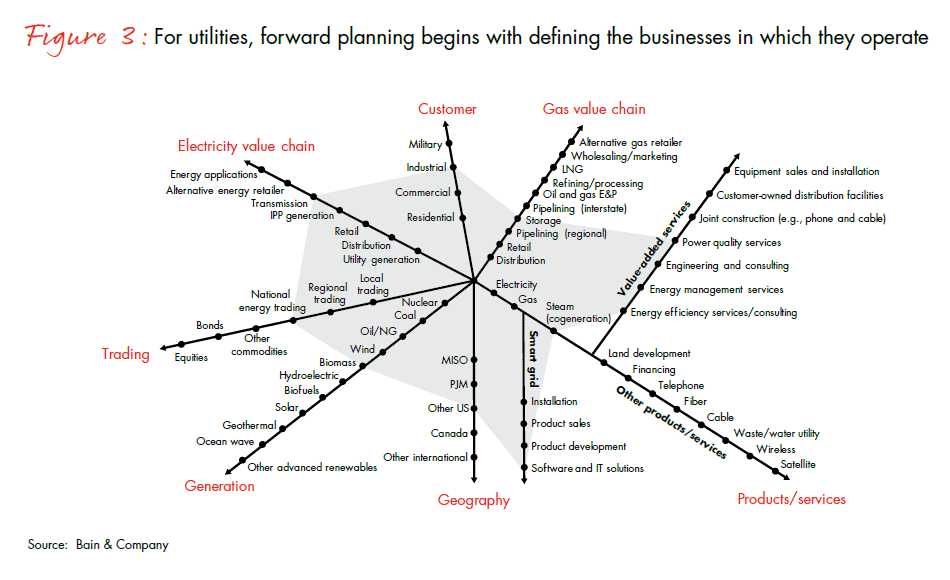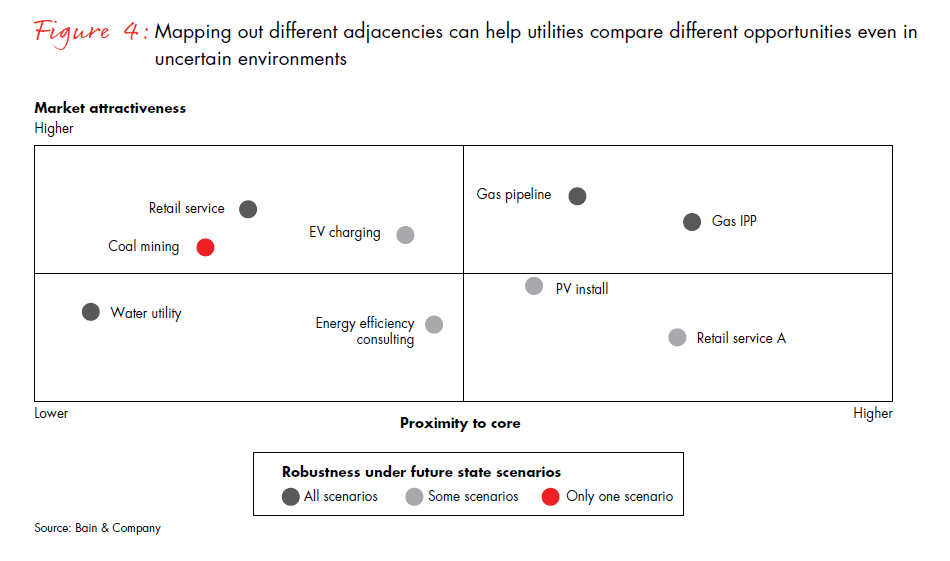Brief
Leading a utility has never been an easy job. A century and a half ago, most gas utilities thought they understood their core business: They provided light to homes and businesses. But when Thomas Edison opened the first central electricity generating station in 1882, his pricing and business plans were aimed directly at taking share from that market—all of it. The stocks of “gas lighting” companies plunged as they scrambled to understand that their true core business—gas distribution—was not defined by the consumer’s appliances.
Today, utilities of all types face a varied list of new threats and obstacles that force them to carefully examine their core.
Fundamental economics pose the first of these challenges. Most developed countries are growing slowly, for instance, so loads in many areas are increasing at a glacial pace. The infrastructure in many regions is aging, and replacement costs are high. Some utilities suffer from overcapacity; others find they must ramp up capacity in certain areas, notably in renewables, in order to meet state mandates. Yet without load growth or at least a more buoyant economy, there is pressure to keep rate increases to a minimum, limiting investment capital.
Evolving commodity and technology trends, meanwhile, introduce uncertainty into the market. Shale gas, for example, has pushed down gas prices and may transform much of the energy market in North America, taking share in power generation from coal and deferring the influx of additional nuclear or renewable capacity. But the environmental and regulatory risks of shale gas have yet to fully play out, and it remains uncertain whether (and in what volume) that gas might be exported, causing gas prices to rise again.
Similarly, digital technologies, such as home smart meters, present utilities with new but relatively untested opportunities to offer creative electricity pricing and home-services businesses tied to energy management and conservation.
Another potential technology disruption comes in the form of distributed generation (DG), particularly from renewable sources. The costs of established technologies like solar photovoltaics continue to decline, while upstarts like Bloom Energy have won high-profile commercial customers such as Wal-Mart, FedEx and Coca‑Cola. In the long term, if DG technologies become cost competitive with centralized generation, they could redefine the entire grid, from generation to transmission to distribution.
Finally, regulation always looms as a potential game changer at many levels—local rates, state-mandated renewables and federal gas export or carbon cap-and-trade policies, to name a few. All these issues—fuel price volatility, shifts in consumer technologies and tastes, and new regulations—have the potential to undermine a utility’s prospects and profitability.
But such a turbulent environment can also present opportunities, provided that utility companies pursue the right strategies and effectively execute them. We believe that a utility company’s best chances for sustained, profitable growth depend on three strategic principles:
- Realize the full potential of the core business
- Invest thoughtfully in select, close-in adjacent Markets
- Proactively scan the environment to identify potential disruptions that create either challenges or opportunities and would drive a change in strategy
To help themselves adhere to these principles despite a 30-year horizon for investment decisions, we recommend that utilities prepare a “strategic options roadmap” to help guide both current and potential future actions. Let’s take a closer look at what we mean by these principles and examine how some utility companies have successfully applied them.
Full potential of the core business
Every company seeks sustained, profitable growth. Analysis of corporate strategic plans suggests that the minimum rate targeted by most companies averages about 5.5% a year. But few achieve this level of growth.
Bain & Company research into the long-term performance of more than 2,000 global companies reveals that only one in eight companies grew revenue and earnings at 5.5% or more while also earning its cost of capital over the 10-year period from 2000 to 2010. We call these elite companies sustained value creators (SVCs). SVCs greatly outperform their peers in terms of total shareholder return, and almost 80% of them follow the approach of building on a strong core business, expanding into close adjacencies (often by applying a tried and tested “repeatable” business model) and proactively adjusting the strategy as the environment changes.
What do we mean by the term “core business”? The core isn’t just whatever industry you happen to be in or the collection of markets you happen to serve. Rather, it reflects at least four dimensions: your most profitable customers, your most differentiated and strategic capabilities, your most critical product offerings and your most important channels.
These assets and capabilities should be identifiable and measurable. They are what distinguish you from competitors.
Think of any successful, well-known company— Apple, say, or Wal-Mart. Even an outsider can see exactly what sets these businesses apart from their rivals and what unique strengths the companies’ management teams must preserve and build on. That collection of relative strengths is their core.
Profiting from the core always involves developing the core to its full potential and often involves divesting non-core businesses. Successful utilities today are doing both. For example, the US utility Wisconsin Energy (WE) developed an ambitious 10-year capital investment program for its core utility starting in 2000. WE invested $7 billion in the utility, while shedding its nuclear plant and other non-core assets. The company also participates in a high growth transmission venture outside of its state-regulated utility business. WE is among the small group of US utilities that have produced an annual total shareholder return of at least 10% since 2003.
Companies, including utilities, sometimes come to believe that their core is tapped out, that the opportunities for growth are limited. If that is really the case, it may be time to branch out beyond the core or even to redefine it, as IBM did when it shifted from hardware into software and services. In many instances, however, management has not yet realized the full potential of the core. There are many examples of companies, including multiple utilities, that prematurely abandoned their core, only to return to it after painful failures pursuing other ventures.
It is a mistake to underestimate either the challenge or the value of capturing the core full potential of utilities. Outsiders may believe that earning a regulated return is somehow less challenging than earning competitive returns in deregulated markets. But achieving the allowable return requires a “repeatable model” in which a utility masters multiple relationships (including state, regulatory and customer constituencies), is able to manage its rate-making efforts in a manner that satisfies both shareholder financial objectives and the needs of other constituents, correctly identifies and executes on investment projects, and maintains safe and effective low-cost operations.
Repeatable models based on a company’s core are the underpinning of sustained, profitable growth. The ability of a utility to consistently translate multiple constituent needs into successful investments and operations at acceptable rates, repeatedly, is integral to sustained profitable growth. For example, in the US, Southern Company has built constructive relationships over time with multiple regulators in multiple states. Since 2000, Southern’s authorized and earned return on equity outpaced industry averages, helping to deliver a 12% annual shareholder return from 2000 to 2010.
Investment in close-in adjacencies
An emphasis on the core does not suggest that utilities must stick to their regulated roots or pass up attractive unregulated opportunities. The core is the center of a business, but it is also the foundation for further growth. Many companies reach a time when their growth and profit performance would benefit from expanding the core. One promising path to growth is to build on the core through moves into adjacent markets.
Adjacencies come in many forms. An adjacent market may involve a new product or line of business, a new set of customers or sales channels, or a new geographic region. A close-in adjacency is one that is only a step away from the core, in the sense that only one part of the core changes. It therefore involves minimal change. For a utility, a close-in adjacency might mean moving from coal generation to gas generation, or expanding from serving residential customers into serving commercial customers. Farther-out adjacencies—moving upstream into gas exploration or processing, say—are likely to involve far greater change, including new customers, new technologies and new competitors.
Yet, any adjacency move is challenging and many fail. The closer it is to the core, the higher the probability of success (see Figure 1). The most successful companies pursue adjacencies through a repeatable model: They move into a close-in adjacency, managing risk by using as many aspects of their core as possible. They then further invest around the adjacency, integrating it over time into their core. They thus learn as they go, increasing the speed of each subsequent move while reducing the risk. For example, in 1998 the predecessor of NextEra Energy Resources launched a 25MW wind project in Oregon. NextEra Energy Resources has built repeatable core capabilities at all stages of wind project development and operation. The company is now the largest wind generator in North America with more than 8GW of capacity. This adjacent growth helped NextEra Energy to return more than 10% annually to its shareholders from 2003 to 2010.

Often the source of adjacency growth for companies lies in their hidden assets—an overlooked capability, asset or relationship embedded within the core which, if positioned differently, could be the source of adjacency growth.
Consider the example of Trane. By the mid-1990s, growth in new construction and new air conditioner installation was slowing. The market was shifting to replacement of existing units and Trane was not winning its fair share. In response, the company identified a hidden asset in its service capabilities and invested heavily behind them. The investment paid off, increasing Trane’s share of replacement units and driving 6% annual growth in pre-tax operating profits in its AC systems and services business from 1998 to 2006.
Within the utility industry, examples of successful adjacency growth built on hidden assets include growth through vertical integration across the gas value chain, operational excellence underpinning mergers and acquisitions (M&As), M&As themselves, and nuclear plant specialization.
For example, in the 1990s, Entergy identified a hidden asset in operating nuclear plants and managing the nuclear fuel cycle. Starting in 1999, the company acquired a succession of nuclear units outside its regulated territory, expanded its offering of nuclear services and achieved a 10-year annual shareholder return of nearly 16%.
In the past decade, US utilities that generated a total shareholder return of 10% or more all focused on core and close-in adjacency growth. Utilities that underperformed that 10% benchmark usually ran into a variety of obstacles, including falling power prices and regulatory lags. But in many cases, poor performance across a wide range of far-removed adjacent businesses was also a key factor (see Figure 2). One utility, for instance, operated businesses in manufacturing and construction, suffering a 20% decline in revenue.

For a utility, as for any company, the process of planning for growth begins with a detailed assessment of where things stand today, which we call “today forward” planning. Three questions are critical:
What business are we in? The answer to this question helps a company define the arena in which it competes and the dimensions that define where it operates and how it is performing relative to its competitors. These include dimensions such as products and services, customers and geographic regions. For utility companies, it may also include elements such as trading, generation and points on the energy value chain (see Figure 3). If two businesses have the same customers, the same cost structure and the same competitors, they are essentially the same business. If they are different on these or other key dimensions, they are different businesses and require separate analysis.

For example, many regulated utilities in the US have both electricity-related and natural gas-related businesses. In many cases, their electric-service and gas-service territories overlap. But they are separate businesses, with distinct cost structures and required capabilities to generate and distribute electricity versus storage, transmission and distribution of natural gas.
What is our competitive position and opportunity in each business? A clear-eyed look at a company’s position relative to its rivals often uncovers strategic possibilities. In particular, it is likely to reveal opportunities to pursue leadership economics. Segment leaders with scale advantage nearly always earn a disproportionate share of profits over and above the cost of capital.
Even for regulated utilities in the US, leadership economics present multiple benefits through the potential for lower rates, higher customer satisfaction and improved regulatory relationships—all of which contribute to long-term profits. By the same token, distant followers in a given business are likely to find themselves competing for the crumbs left by the leaders.
Competitive analysis of this sort may also reveal capability gaps in each segment—the holes a utility company must fill before it embarks on a growth program.
For example, if you want to move from gas distribution to transmission, do you possess the technical expertise you will need or will you have to acquire it? If you plan to move into new countries, how similar are the regulatory environments to those you are accustomed to? Asking these questions can help ensure that enthusiasm for new growth opportunities does not obscure the fact that capabilities—and therefore the odds of success—decline with distance from the core.
Where are the opportunities to develop repeatable models? As we mentioned earlier, companies that are most successful at both their core and in their adjacency moves typically develop a repeatable model for their moves, and then execute them one after the other. Successful companies screen growth initiatives for repeatability, because a repeatable model almost invariably leads to lower costs, less complexity, better implementation and faster decision making. A utility can harness the power of repeatability in other ways as well.
One example is the UK utility Centrica. Centrica is a leading practitioner of the Net Promoter® system, which aims to generate growth by focusing the company on improving customer loyalty. Centrica uses its Net Promoter system to provide closed-loop feedback to the front lines of its business—a critical element of repeatable business models. This has translated into breakthrough results in businesses like British Gas Services’ home heating installation, which turned around from a shrinking revenue base to a 30% growth rate in less than three years.
Mindful of the long time horizons for their investments, most successful utility companies complement conventional today-forward planning with longer-range scenario creation, which we call future-back planning. They use data and trend analysis to create imagined future states and then assess threats and opportunities on the basis of these scenarios. Such a task can seem hopelessly daunting, of course, since there is no real way of knowing what the landscape will look like 20 or 30 years down the road. But the goal isn’t to cover every possibility. Rather, it is to identify the most likely disruptions to the current business model, assess their impact as accurately as possible and then monitor the critical variables over time so that decisions can be adjusted as necessary.
The first step in future-back planning is to identify broad trends that can be isolated into specific variables that will impact the business. For example, regulatory trends include changes in environmental and regulatory incentives regarding carbon emissions, increasing openness to competitive suppliers, or the likelihood of feed-in tariffs. Technology trends might include developments in distributed generation, central station renewables or the demand for plug-in hybrid electric vehicles. Input cost and supply trends could include labor costs, commodity supply and prices and plant construction. Consumer demand trends include changes in raw demand, demand by customer type and service area and per-capita demand.
Typically, this kind of scenario planning permits a utility company to identify three to five likely future states. These, in turn, allow the company to develop a set of strategic options to both drive the core to full potential and pursue adjacency growth.
Achieving the full potential of the core requires that utilities identify “just do it” actions—actions that make sense under any scenario. Examples of these types of actions include improvements to operating costs, customer advocacy or employee engagement.
Pursuing adjacent growth in uncertain environments requires analysis beyond typical measures of market attractiveness and proximity to the core business. It must also take into account how a given opportunity would fare—its “robustness”—under the different future state scenarios the utility has identified. For example, investing in a network of electric vehicle charging stations might be attractive in a scenario with sustained $150/barrel oil prices and carbon taxes, but far less attractive under alternative scenarios.
One way of evaluating these adjacencies is to map them on a grid that integrates the three criteria of market attractiveness, proximity to the core and robustness (see Figure 4).

Strategic options roadmap
The kind of analysis described above allows a company to develop a strategy to bring the core business to full potential, while also investing in close-in, attractive adjacent markets. In the utility industry, however, that’s not enough. Given the long investment time horizons and the potential for major changes in policies, technologies, input prices and customer preferences, it’s critical for utility companies to develop strategic options.
A strategic options roadmap proactively identifies emerging changes to the environment or “signposts” that should prompt a utility to modify its strategy (see Figure 5). For example, the widespread adoption of distributed generation systems would be highly disruptive to many US utilities businesses. A utility can proactively scan the environment and make adjustments to its strategy by monitoring distribution generation related “signposts” that might include:
- Cost trends of distributed generation
- Technological developments likely to shift the cost curve
- Policy and regulatory changes likely to affect the attractiveness of distributed generation

Developing a robust strategy
Developing and executing a robust, flexible strategy is no small undertaking. And for utility companies in particular, it is a task complicated by challenging economics, shifting markets, potentially disruptive technologies and regulatory uncertainty.
Utility companies that focus on maximizing the performance of their core business, use a repeatable model to invest selectively in close adjacencies, and proactively monitor and respond to changes in the environment have a tremendous advantage. Setting a strategy that extends well into the future—and has the flexibility to evolve—is no easy task, but history tells us that shareholders will reward utilities that effectively do so.
Mark Gottfredson is a partner with Bain & Company in Dallas and has led the firm’s Global Performance Improvement practice. Bruce Stephenson is a partner in the Chicago office and a leader of Bain’s Utilities practice. Jason Glickman is a principal in Bain’s Chicago office and a member of Bain’s Utilities practice.
The most successful companies ensure their strategy incorporates three key elements:
- A baseline strategy that drives the core to full potential and invests in close-in adjacencies through a repeatable model.
- A strategic options roadmap to create multiple options for growth in an uncertain environment. This requires a utility to think about the major trends that can disrupt its business and the opportunities those trends present. They will monitor those trends closely, month in and month out, creating signposts and guidelines to inform strategic decisions. They will rely on hard numbers and analysis to evaluate the trends, avoiding decisions made on gut feel alone.
- A strategic planning process that enables the utility to actively monitor and update the signposts, and to have the discipline to make changes in the strategy as the environment changes.






Repeatability
Learn more about how executives use Repeatable Models® to build enduring businesses.